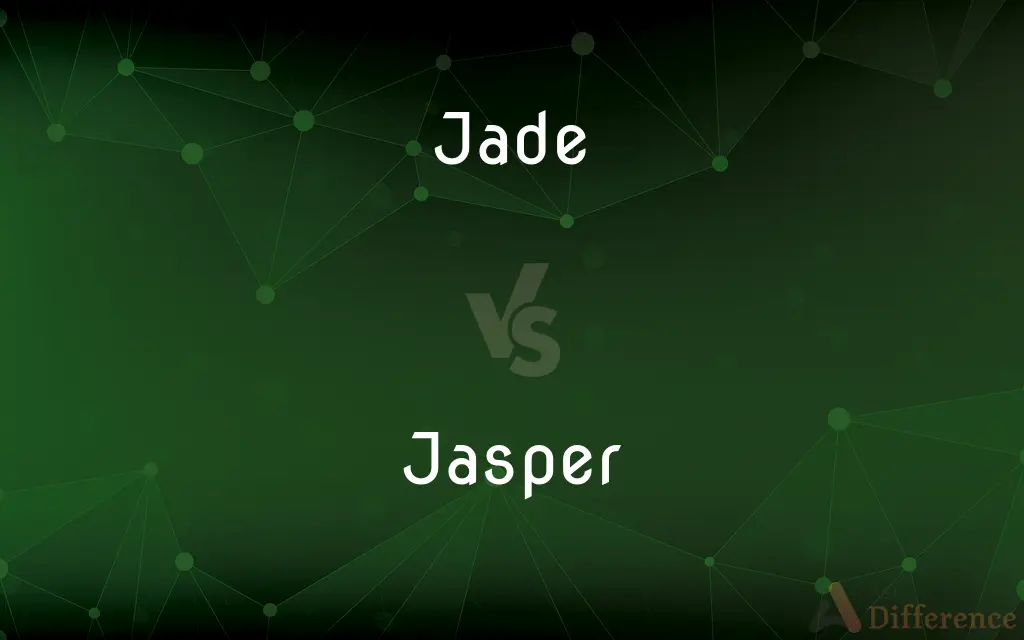Jade vs. Jasper — What's the Difference?
By Tayyaba Rehman — Updated on October 20, 2023
Jade is a hard, green stone often used in carvings and jewelry. Jasper is an opaque, often multicolored stone used for ornaments and cabochons. Both are ornamental minerals valued for their aesthetics.

Difference Between Jade and Jasper
Table of Contents
ADVERTISEMENT
Key Differences
Jade, an ancient stone cherished especially in Asian cultures, has been utilized for thousands of years for its beauty and durability. It is primarily composed of two minerals, nephrite and jadeite, which contribute to its unique green color and lustrous appearance. Jasper, on the other hand, belongs to the chalcedony family of quartz and is recognized for its opaqueness and variety of patterns and colors.
Jade is renowned for its hardness and toughness, making it ideal for intricate carvings, jewelry, and tools. Its color range, mainly dominated by greens, can also span to whites, pinks, and blues depending on its mineral content. Jasper, in comparison, showcases a vivid array of colors including red, yellow, brown, or green, often marked with unique patterns, stripes, or spots, a testament to the iron and other impurities within.
The cultural significance of Jade is immense, particularly in China where it's often linked to virtues like purity, nobility, and wisdom. It's not just a gemstone but a symbol of status, spirituality, and health. Jasper, while also holding spiritual and healing attributes in various cultures, is prized for its ornamental value, often cut into cabochons or beads for jewelry.
Jade, when examined under the microscope, exhibits interlocking granular structures, contributing to its toughness. This structure is distinct from many other gemstones. Jasper's microscopic view reveals its microcrystalline nature, a quality it shares with other forms of quartz, lending it a smooth and often waxy luster.
While both Jade and Jasper are used in the jewelry industry, their differences in mineral composition, appearance, and cultural significance make them distinct. Jade's premium standing, especially in Asian markets, often commands higher prices, while Jasper's diverse palette appeals to those seeking varied patterns and hues.
ADVERTISEMENT
Comparison Chart
Composition
Nephrite or Jadeite
Chalcedony (a type of Quartz)
Appearance
Usually green, can be varied
Multicolored, often with patterns or spots
Hardness
Hard and tough
Less hard than Jade
Cultural Use
Symbol of purity in Asia
Prized for ornamental value
Luster
Lustrous
Often waxy luster
Compare with Definitions
Jade
An outgoing, often flirtatious girl.
Jasper
An opaque, usually multicolored stone used for ornaments and jewelry.
His cufflinks were made of red Jasper.
Jade
A shade of green resembling the stone.
The walls were painted a calming Jade hue.
Jasper
A gemstone believed to bring grounding energy and protection.
Some believe wearing Jasper can ward off negative vibes.
Jade
Jade is an ornamental mineral, mostly known for its green varieties, though it appears naturally in other colors as well, notably yellow and white. Jade can refer to either of two different silicate minerals: nephrite (a silicate of calcium and magnesium in the amphibole group of minerals), or jadeite (a silicate of sodium and aluminium in the pyroxene group of minerals).
Jasper
A stone often cut into cabochons for jewelry due to its decorative patterns.
The artisan chose Jasper for its vibrant and unique appearance.
Jade
A hard, typically green stone used for ornaments and implements and consisting of the minerals jadeite or nephrite
A jade figurine
Jasper
A mineral composed largely of silicon dioxide with various impurities giving it color.
Jasper's beautiful color variations are due to its mineral content.
Jade
A bad-tempered or disreputable woman.
Jasper
A form of chalcedony with colorful inclusions or patterns.
The ring showcased a Jasper stone with a striking pattern.
Jade
An old or worn-out horse.
Jasper
A wasp.
Jade
Either of two distinct minerals, nephrite and jadeite, that are generally pale green or white and are used mainly as gemstones or in carving.
Jasper
Jasper, an aggregate of microgranular quartz and/or chalcedony and other mineral phases, is an opaque, impure variety of silica, usually red, yellow, brown or green in color; and rarely blue. The common red color is due to iron(III) inclusions.
Jade
A carving made of jade.
Jasper
An opaque cryptocrystalline variety of quartz that may be red, yellow, or brown.
Jade
Jade green.
Jasper
(obsolete) Any bright-coloured kind of chalcedony apart from cornelian.
Jade
A broken-down or useless horse; a nag.
Jasper
An opaque, impure variety of quartz, of red, yellow, and other dull colors, breaking conchoidally with a smooth surface.
Jade
A woman regarded as promiscuous.
Jasper
Jasperware pottery.
Jade
A semiprecious stone, either nephrite or jadeite, generally green or white in color, often used for carving figurines.
Jasper
A person, a guy, especially seen as naïve or simple.
Jade
A bright shade of slightly bluish or greyish green, typical of polished jade stones.
Jade green
Jasper
(transitive) To decorate with, or as if with, jasper.
Jade
A succulent plant, Crassula ovata.
Jasper
An opaque, impure variety of quartz, of red, yellow, and other dull colors, breaking with a smooth surface. It admits of a high polish, and is used for vases, seals, snuff boxes, etc. When the colors are in stripes or bands, it is called striped jasper or banded jasper. The Egyptian pebble is a brownish yellow jasper.
Jade
A horse too old to be put to work.
Jasper
An opaque form of quartz; red or yellow or brown or dark green in color; used for ornamentation or as a gemstone
Jade
A bad-tempered or disreputable woman.
Jade
Of a grayish shade of green, typical of jade stones.
Jade
To fatigue, tire, or weary (someone or something).
Jade
(obsolete) To treat (someone or something) like a jade; to spurn.
Jade
(obsolete) To make (someone or something) contemptible and ridiculous.
Jade
A stone, commonly of a pale to dark green color but sometimes whitish. It is very hard and compact, capable of fine polish, and is used for ornamental purposes and for implements, esp. in Eastern countries and among many early peoples.
Jade
A color resembling that of jade{1}; it varies from yellowish-green to bluish-green.
Jade
A mean or tired horse; a worthless nag.
Tired as a jade in overloaden cart.
Jade
A disreputable or vicious woman; a wench; a quean; also, sometimes, a worthless man.
She shines the first of battered jades.
Jade
A young woman; - generally so called in irony or slight contempt.
A souple jade she was, and strang.
Jade
To treat like a jade; to spurn.
Jade
To make ridiculous and contemptible.
I do now fool myself, to let imagination jade me.
Jade
To exhaust by overdriving or long-continued labor of any kind; to tire, make dull, or wear out by severe or tedious tasks; to harass.
The mind, once jaded by an attempt above its power, . . . checks at any vigorous undertaking ever after.
Jade
To become weary; to lose spirit.
They . . . fail, and jade, and tire in the prosecution.
Jade
A semiprecious gemstone that takes a high polish; is usually green but sometimes whitish; consists of jadeite or nephrite
Jade
A woman adulterer
Jade
A light green color varying from bluish green to yellowish green
Jade
An old or over-worked horse
Jade
Get tired of something or somebody
Jade
Exhaust or tire through overuse or great strain or stress;
We wore ourselves out on this hike
Jade
Similar to the color of jade; especially varying from bluish green to yellowish green
Jade
A hard, typically green stone used in jewelry and ornamental items.
She wore a beautiful necklace made of Jade.
Jade
A tool or ornament made of jade stone.
He gifted her a Jade pendant on her birthday.
Jade
A symbol of purity, protection, and nobility, especially in Chinese culture.
In their tradition, gifting Jade signifies wishing good fortune.
Jade
Either of two minerals, nephrite or jadeite, that are generally green and used for carving.
The museum showcased artifacts carved from both types of Jade.
Common Curiosities
Why is Jade often green?
Jade's green color primarily comes from its composition, either nephrite or jadeite, though it can be found in other colors too.
How do Jade and Jasper differ in terms of hardness?
Jade is tougher and harder, whereas Jasper is less hard than Jade.
What are the common colors of Jasper?
Jasper can be red, yellow, brown, green, and more, often with unique patterns or spots.
What is the cultural significance of Jade in China?
Jade is a symbol of purity, nobility, and wisdom in Chinese culture.
Is red Jasper really red?
Red Jasper can range from a brick red to a reddish-brown, depending on its iron content.
What is Jade primarily used for?
Jade is mainly used for jewelry, carvings, and as a symbol of purity in certain cultures.
Is Jasper a form of Jade?
No, Jasper is a form of chalcedony, while Jade is primarily composed of nephrite or jadeite.
Which is more lustrous, Jade or Jasper?
While both can be lustrous, Jade generally has a more lustrous appearance, while Jasper can have a waxy luster.
Can you find both Jade and Jasper in the USA?
Yes, both minerals can be found in various locations within the USA.
Is Jade more expensive than Jasper?
Typically, yes. Jade, especially of high quality, can command higher prices than Jasper.
Is Jasper used for any spiritual or healing purposes?
Yes, in various cultures, Jasper is believed to provide grounding energy and protection.
Why is Jade often associated with good luck?
Historically, especially in Asian cultures, Jade has been seen as a protector and bringer of good fortune.
Do both Jade and Jasper have historical importance?
Yes, both stones have been used and valued by various cultures for thousands of years.
How can I tell if my Jade is real?
Genuine Jade is cool to touch, hard, and has a specific gravity and refractive index that can be tested.
Is it common to find both Jade and Jasper in the same piece of jewelry?
While not extremely common, it's possible, especially in pieces that aim to combine different stones for aesthetic or symbolic reasons.
Share Your Discovery

Previous Comparison
Liquor vs. Liquorice
Next Comparison
Two vs. TowAuthor Spotlight
Written by
Tayyaba RehmanTayyaba Rehman is a distinguished writer, currently serving as a primary contributor to askdifference.com. As a researcher in semantics and etymology, Tayyaba's passion for the complexity of languages and their distinctions has found a perfect home on the platform. Tayyaba delves into the intricacies of language, distinguishing between commonly confused words and phrases, thereby providing clarity for readers worldwide.














































